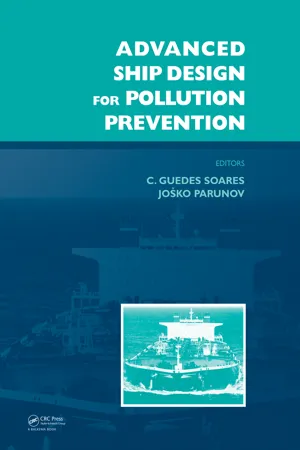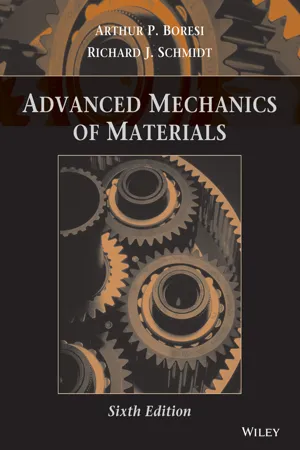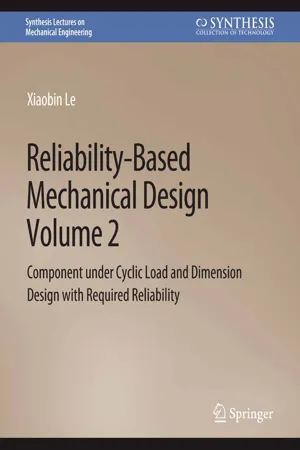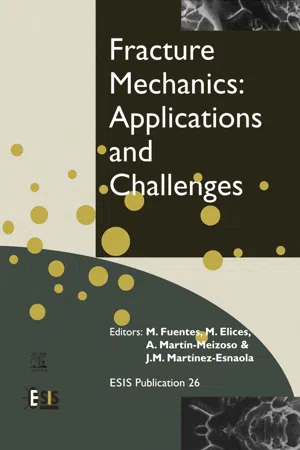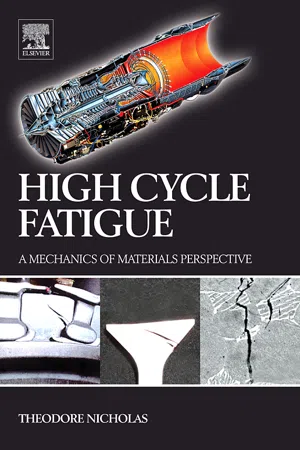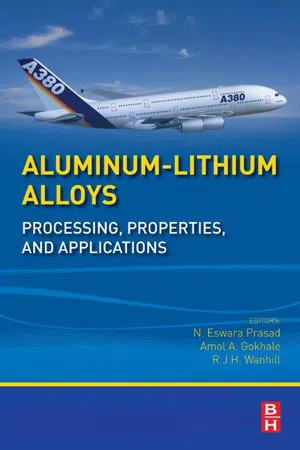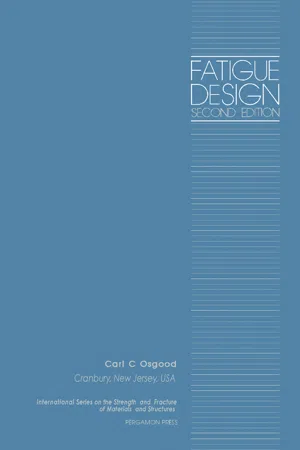Technology & Engineering
Low Cycle Fatigue
Low cycle fatigue refers to the failure of a material subjected to a small number of stress cycles before fracturing. This type of fatigue is typically associated with high-stress levels and can lead to rapid crack growth and failure. It is a critical consideration in the design and maintenance of engineering structures and components, particularly in applications involving cyclic loading.
Written by Perlego with AI-assistance
Related key terms
1 of 5
11 Key excerpts on "Low Cycle Fatigue"
- eBook - ePub
Fatigue of Materials and Structures
Fundamentals
- Claude Bathias, André Pineau, Claude Bathias, André Pineau(Authors)
- 2013(Publication Date)
- Wiley-ISTE(Publisher)
Chapter 4Low-cycle Fatigue 1
4.1. Introduction
4.1.1. Application domain of low cycle plastic fatigue
As we expect from its name, Low Cycle Fatigue (LCF) has two fundamental aspects: – a significant plastic deformation occurs in each cycle, i.e. plasticity; – low cycle phenomenon, in that the materials have a finite endurance for this type of loading. Analysis of material behavior under this type of loading is quite common.4.1.1.1. BackgroundIndeed, if the first studies on the role of plastic deformation on fatigue endurance go back to the early 20th century: Bauschinger (1886) to Bairstow (1909), we have to wait until 1948 for the first strain-controlled tests to be carried out (Liu, Lynch and Ripling) and 1952–1953 for the formulae relating endurance to strain amplitude to be proposed (Manson and Coffin [COF 54, MAN 52]). Since then, studies on fatigue have been rapidly multiplied and their importance has been emphasized.The interest in the studies related to Low Cycle Fatigue lies mainly in two fields: – application to the size and design of components in aeronautics, energy production, etc., which can be performed using advanced calculation methods;– the use of LCF results allows us to analyze the behavior of the materials in greater detail and to better understand the complex mechanical and metallurgical phenomena (strain concentration, crack propagation, work-hardening, work-softening, etc.).4.1.1.2. Low-cycle fatigue in structural analysisIndustrial devices are calculated in such a way that the materials in the main structures are not loaded within the plastic domain under normal operating conditions. “Primary” stresses are those that depend mainly on imposed forces and do not disappear under plastic deformation. “Secondary” stresses are those that are mainly due to imposed displacements and relax under a limited plastic deformation. If primary stresses are kept strictly below some fraction of the elastic limit of the materials, “secondary” stresses can be slightly higher than the elastic limit. - Carlos Guedes Soares, Joško Parunov(Authors)
- 2010(Publication Date)
- CRC Press(Publisher)
163 Advanced Ship Design for Pollution Prevention – Guedes Soares & Parunov (eds) © 2010 Taylor & Francis Group, London, ISBN 978-0-415-58477-7 High cycle and Low Cycle Fatigue in ship structures S. Rudan Faculty of Mechanical Engineering and Naval Architecture, University of Zagreb, Zagreb, Croatia ABSTRACT: Ship structures are particularly prone to fatigue of material. As they sail wave loads and other cycling loads are acting on ship structural details and fatigue damage is being accumulated. Two main types of fatigue may be distinguished: high cycle fatigue, with moderate loads in big number of cycles, and Low Cycle Fatigue, with high loads in medium number of cycles. Both can cause fatigue failure, but a combination of the two even more. However, the problem of combined HCF and LCF is yet to be understood thoroughly. This paper gives an introduction in the state-of-the-art HCF and simplified LCF calculations. It points out to several models proposed for HCF and LCF combination into resulting fatigue. Procedures are illustrated through one numerical example and results are discussed. ter fits the purpose. In addition, the cracks in ship structures may sometimes grow for meters in length before becoming a threat to the ship integrity. On the other hand LCF is not as extensively investi-gated and the reasons for that will be explained. LCF tends to shorten, sometimes significantly, the life of structural details that include notches, imperfections, micro cracks and any other possi-ble source of highly stressed local regions. Finally, combination of HCF and LCF in ship structures is only recently being systematically examined. This paper addresses some of the procedures available for estimating HCF, LCF and their com-bined effect on fatigue life of ship structural details. HCF analysis is presented through state-of-the-art spectral fatigue analysis, which is a procedure for direct fatigue damage calculation.- eBook - PDF
- Arthur P. Boresi, Richard J. Schmidt(Authors)
- 2019(Publication Date)
- Wiley(Publisher)
Failure resulting from Low Cycle Fatigue is treated briefly in Section 16.4. For a more extensive treatment, the reader is referred to the literature (Sandor, 1972; Manson, 1981; Klesnil and Lukáš, 1992). Fatigue failures may occur with only small plastic strains. Such failures are called brittle failures resulting from high cycle fatigue. For members made of ductile metals, high cycle fatigue failure occurs after about 10 6 cycles. High cycle fatigue failure is considered in Sections 16.1–16.3. 16.1 FRACTURE RESULTING FROM CYCLIC LOADING A basic concept in fracture predictions by fracture mechanics analysis is the existence of a critical crack size for a given geometry and load. In some practical applications, the size of the critical crack or defect is so large that the crack’s effect can usually be detected and corrected before the part is put into service or during maintenance of the part in service. However, most parts contain subcritical cracks or flaws. These subcritical cracks may, dur- ing operation, grow to critical size and cause catastrophic failures. Several mechanisms of subcritical crack growth exist. Of particular importance in practical problems are the mecha- nisms of fatigue and stress corrosion cracking. Here we briefly consider fatigue criteria asso- ciated with subcritical crack growth by the mechanism of fatigue. The mechanism of stress corrosion cracking is left to more specialized works (Clarke and Gordon, 1973; Fuchs and Stephens, 1980, Chapter 11). However, one should note that fatigue crack growth processes cannot be fully explained unless the effects of the environment (corrosion) are considered. 16.1 FRACTURE RESULTING FROM CYCLIC LOADING 569 Encouraged by the success of linear elastic fracture mechanics (LEFM) in explaining sudden brittle fracture, several investigators have attempted to describe subcritical crack growth in terms of LEFM parameters. - eBook - PDF
Reliability-Based Mechanical Design, Volume 2
Component under Cyclic Load and Dimension Design with Required Reliability
- Xiaobin Le(Author)
- 2022(Publication Date)
- Springer(Publisher)
This chapter will present and discuss different methods to determine the reliability of a component under any cyclic load with plenty of examples. 2.2 FATIGUE DAMAGE MECHANISM Fatigue phenomena were first discovered and studied during the 19th century with the arrival of machines and freight vehicles during the industrial revolution [1]. Fatigue is defined as “failure under a repeated or varying loading, which never reaches a level sufficient to cause failure in a single application.” Fatigue failure of a metal component under cyclic loading is a complicated phenomenon, and only partially understood [2]. However, we have a fundamental understanding of fatigue 10 2. RELIABILITY OF A COMPONENT UNDER CYCLIC LOAD failure or fatigue damage. Fatigue damage is the weakening of a metal material due to a gradually crack propagation of inherent existing microscopic cracks or defect inside or on the surface of the metal component under repeated cyclic loading. Without a crack inside or on the surface of a metal component, there is no fatigue. If the magnitude of cyclic loading is not big enough to generate a crack propagation, there will be no fatigue. The fatigue damage mechanism can be typically described by the following four stages. Let use a microscopic crack on the surface to explain and demonstrate these. Figure 2.1 shows a magnified microscopic crack on the surface of a component under a fully reversed cyclic bending moment. In this example, let us assume that the nominal normal stress due to the bending stress is 20 ksi, and the material yield strength is 60 ksi. 1. Crack initiation. There are always lots of randomly distributed defects inside a component such as voids and dislocations and on the surface of a component such as manufacturing scratches [3]. A fatigue crack will typically initiate at a microscopic crack or defect inside or on the surface of a component. - M. Fuentes, M. Elices, A. Martín-Meizoso, J.-M. Martínez-Esnaola(Authors)
- 2000(Publication Date)
- Elsevier(Publisher)
13 SOME ASPECTS OF FATIGUE OF ENGINEERING MATERIALS HAEL MUGHRABI Institut ffir Werkstoffwissenschaften, Lehrstuhl I, Universitfit Erlangen-Nfirnberg Martensstr. 5, D-91058 Erlangen, Federal Republic of Germany ABSTRACT Fatigue failures are generally the result of repeated plastic cyclic microstrains leading ultimately to the initiation and propagation of cracks. Fatigue crack initiation (and propagation) can occur in different ways and is frequently preceded by some form of cyclic strain localization. In this presentation, examples will be given of different types of fatigue studies on a number of metallic engineering (and model) materials. The aim will be to highlight different aspects of fatigue behaviour and to illustrate different experimental approaches in the study of fatigue phenomena. Some topics of current interest will be addressed, referring to recent work on the fatigue behaviours of materials of ultrafine grain size, metal-matrix composites, a cast magnesium alloy and, finally, the high-temperature fatigue of monocrystalline nickel-base superalloys. KEYWORDS Fatigue life, ultrafine grain-size materials, metal-matrix composites, cast magnesium alloys, nickel-base superalloys, elastic compliance, damage parameter, fatigue crack initiation, fatigue crack propagation, microstructure. INTRODUCTION Fatigue fracture is one of the most common types of materials failure. It occurs in materials and components subjected to repeated cyclic loads which would normally not cause damage, if applied only once monotonically. It is now well established that fatigue damage originates from (small) repeated cyclic microstrains (in the order of 10.5 to 10-2) which ultimately lead to some form of strain localization, followed by subsequent initiation and propagation of cracks in the case of ductile materials and to almost immediate propagation of cracks in the case of less ductile high-strength materials.- eBook - PDF
High Cycle Fatigue
A Mechanics of Materials Perspective
- Theodore Nicholas(Author)
- 2006(Publication Date)
- Elsevier Science(Publisher)
4.4. DESIGN CONSIDERATIONS Damage tolerant design, when applied to LCF alone, is based on inspection size capability for cracks, crack-growth-rate computations, and the determination of proper inspection intervals to locate cracks before they reach a critical size. In an aeroengine, the LCF cycles are related to the number of flights and are fairly well determined by usage. For a component experiencing both LCF and superimposed vibratory (HCF) loading, the HCF contribution to the growth rate must also be considered. In particular, for high frequency vibrations where the number of HCF cycles can be large, reaching the threshold for HCF can be the governing criterion for failure because the crack-growth rate under the combined LCF–HCF loading may accelerate far beyond that for LCF alone. Predicting the onset of the HCF activity thus becomes an important aspect for design and component lifing [49]. Wanhill [50], for example, has pointed out the importance of the use of K th for design. He considers that clearly, the most significant application of fatigue thresholds includes the case of combined LCF–HCF loading where the LCF grows the crack until the threshold for HCF is reached. Whether or not the threshold value obtained from long cracks, K th , can be used to asses the onset of accelerated growth under combined LCF–HCF loading, has yet to be determined for most materials and loading conditions. These conditions involve various combinations of R for the major and minor cycles as well as the number of HCF cycles per LCF “block.” Crack growth under the conjoint action of HCF and LCF was studied by Powell et al. [51]. The objective was to see when the HCF accelerated the steady-state LCF growth rate and how this was related to the threshold for HCF. Two titanium alloys were studied, Ti-6Al-4V and Ti-5331S, the latter also known as IMI829. - P.D. Portella, K.-T. Rie(Authors)
- 1998(Publication Date)
- Elsevier Science(Publisher)
Low Cycle Fatigue tests were carried out over a wide range of plastic strain levels including an Extremely Low Cycle Fatigue (ELCF) regime on two kinds of Ferritic Ductile Cast Iron (FDI) having fine- and coarse-grained graphites. To clarify the fracture mechanism in an ELCF regime, observation of microfracture behavior was also performed both on the surface and on a longitudinal section of partially fatigued specimens. In an Ordinary LCF regime, a fatal crack is formed by the propagation and frequent coalescence of small surface cracks. In an ELCF regime, however, an internal crack formed by coalescence of microvoids, which originate from the debonding of matrix-graphite interface inside the material, leads to final fracture of a specimen.KEYWORDS Extremely Low Cycle Fatigue fracture mode transition ferritic ductile cast ironINTRODUCTION
Since a Ferritic Ductile Cast Iron (FDI) has excellent mechanical properties, it is now widely used in place of steel as the preferred material for various machine parts, such as crankshafts, camshafts and different types of gears. With increased demands for application of this material in various fields of industry, it has become important to clarify the fatigue fracture mechanism under severe loading conditions, such as that of a Low Cycle Fatigue, including an Extremely Low Cycle Fatigue (ELCF) regime.ELCF is a fatigue phenomenon at a very high level of plastic strain range Δεp where fatigue life is less than about 100 cycles[1 –3 ]. It is very important to have some basic knowledge concerning the fracture mechanism of FDI in an ELCF regime in order to prevent a catastrophic failure of machine components and structures during destructive earthquakes. However, many problems concerning the fatigue damage in an ELCF regime, remain unsolved.The aims of the present study are (i) to clarify the fatigue fracture mechanism of FDI in an ELCF regime and (ii) to discuss the microstructural effect on fracture behavior both in an Ordinary LCF and ELCF regime.MATERIALS AND METHODS
Two types of ferritic ductile cast iron, having fine- and coarse-graphite, were used in this study. Typical microstructures of both materials are shown in Fig. 1 . Mechanical properties and metallurgical parameters are given in Table 1- eBook - ePub
Aluminum-Lithium Alloys
Processing, Properties, and Applications
- N Eswara Prasad, Amol Gokhale, R.J.H Wanhill(Authors)
- 2013(Publication Date)
- Butterworth-Heinemann(Publisher)
Eswara Prasad and Rama Rao (2000) .Part B: High Cycle Fatigue (HCF)
11.6 Introduction to the HCF Behavior of Aluminum Alloys
Wöhler’s seminal work on the stress-controlled cyclic loading effects on the life of railway carriage axles led to the archetypal basic HCF plot showing the variation of stress (σ ) with number of cycles to failure (N f ), commonly known as an S–N curve or Wöhler curve (Wöhler, 1860 ). A schematic of basic stress (S)–fatigue life (N) curves is shown in Figure 11.12 . Such plots show the variation of cyclic (alternating) stress amplitude (σ a ) with fatigue life (N f ) using either linear–log or log–log coordinates, and generally run to about 107 cycles. The value of stress amplitude (σ a ) at 5×106 –107 cycles is known or referred to as the fatigue limit or endurance limit (σ e ). Figure 11.12 also shows the variation in σ a values when the materials or components are subjected to HCF with tensile or compressive mean stresses. Beyond this limit, the specimen or component is deemed to have infinite fatigue life. It is often assumed that the fatigue limit (also called the fatigue strength) corresponds to the case where the specimen or component is under the influence of only elastic stresses, that is, there is no plasticity at the global level. Both these assumptions are incorrect, but for a spectrum of current engineering applications the HCF fatigue limit is sufficient. Several fundamental, applied, and mechanistic approaches to both analyze and apply the HCF properties of structural materials have become part of the basic design philosophy for purposes of material selection and component design (Hertzberg, 1989 ; Nicholas, 2006 ; Suresh, 2001 ; Wöhler, 1870 - H. Liebowitz(Author)
- 2014(Publication Date)
- Academic Press(Publisher)
Many materials exhibit a fatigue limit which is a fraction of their engineering yield limit. It is well known that microplastic deformations occur well below the onset of overall plastic deformation. That these microplastic, deformations can be irre-versible and can accumulate under a cyclically applied load has been demonstrated on Armco iron. Catastrophic yielding associated with Luder's band propagation occurred suddenly after a few hundred or a few thousand (depending on load level) applications of loads that were well under the load intensity which produces yielding at the first applica-tion (Branger and Ronay, 1970). Fatigue failure always starts at some discontinuity causing a stress (strain) concentration. While the overall static yield limit is even increased by the presence of a notch, resistance to fatigue failure might be reduced by a factor of two or more. Cyclic loading itself may create discontinuities on a previously featureless surface leading to local concentration of strain. It can be stated that fatigue failure does not occur in the absence of any kind of strain concentration. The extensive fatigue research done in the past falls into two groups, according to purpose. The first group is concerned with the basic mechanism of fatigue, while the second group concentrates on collecting and representing data on the basis of which either the fatigue strength or the fatigue life of engineering structures are to be predicted. While this type of research was performed mainly on engineering alloys of high strength, it aimed at neither an understanding of the nature of the fatigue process in these alloys nor at the systematic investigation of the various types of interactions due to variation of stress, both in space and time, which occurs in a structure under service conditions.- eBook - PDF
Fatigue Design
International Series on the Strength and Fracture of Materials and Structures
- Carl C. Osgood, D. M. R. Taplin(Authors)
- 2013(Publication Date)
- Pergamon(Publisher)
CHAPTER 4 GENERAL FACTORS 4.1 The Mechanism of Fatigue 4.1.1 Summary Investigations into the physical aspects of fatigue have revealed four salient points which appear common to many, if not all, metals and alloys. 1. Slip on an atomic lattice plane starts at a common value of critical resolved shear stress, approximately 200 psi, and at a common strain of 10 2. The slope of the plastic strain vs. the failure cycles curve, (ε ρ vs. N f ) i s common at -1/2. 3. A value of 1% plastic strain causes failure in about 1000 cycles. 4. The structural metals and alloys divide generally into two groups: those which cyclically strain-harden, and those which cyclically strain-soften; while a few (e.g., copper) will do either depending on their initial state. 4.1.2 Discussion While progressive cracking as a result of slip on the atomic planes is fairly well-accepted as a description of the fatigue process, discussion continues of the appli-cability of the several crack propagation laws. The terms fatigue and damage (or loss of loading capacity) should be synonymous, and the sequence of words in the title of this Section might imply that the funda-mental process or mechanism by which the damage occurred was well known. Nothing could be further from the truth. Despite the enormous expenditure of talent, time and money during the last century or so, the fundamentals have yet to be measured and described mathematically. Some of this difficulty undoubtedly lies in our insufficient knowledge of the solid state in terms of the detailed properties of the polycrystalline alloys, and some perhaps in our inability to interpret properly the vast amount of data already on hand. But the fatigue investigator and the crystallographer have recently corre-lated enough of their results to provide us with a fairly adequate picture of the process. - eBook - PDF
- Andrea Carpinteri, Manuel De Freitas, Andrea Spagnoli(Authors)
- 2003(Publication Date)
- Elsevier Science(Publisher)
5. LOW CYCLE MULTIAXIAL FATIGUE This Page Intentionally Left Blank Biaxial/Multiaxial Fatigue and Fracture Andrea Carpinteri, Manuel de Freitas and Andrea Spagnoli (Eds.) © Elsevier Science Ltd. and ESIS. All rights reserved. 383 A MULTIAXIAL FATIGUE LIFE CRITERION FOR NON-SYMMETRICAL AND NON-PROPORTIONAL ELASTO-PLASTIC DEFORMATION Mauro FILIPPINl' , Stefano FOLETTl loannis V. PAPADOPOULOS^ and Cetin Morris SONSINO^ Dipartimento di Meccanica, Politecnico di Milano, Milano, Italy 2 European Commission, JRC, IPSC, Ispra, Italy Fraunhofer-Institute for Structural Durability LBF, Darmstadt, Germany ABSTRACT A new low-cycle multiaxial fatigue life prediction methodology based on the concept of an effective shear strain is proposed. This effective shear strain is derived by averaging the total shear strains acting on all planes passing through a material point. The proposed model, which is formulated as a generalised equivalent strain, takes into account the effect of non-symmetrical loading cycles. The main advantage of the model relies on the small number of material parameters to be identified. The axial cyclic stress-strain curve, the basic strain-life curve (Manson-Coffin) and an additional life curve obtained under zero to tension strain controlled axial fatigue tests are sufficient to allow application of the proposed criterion in all loading conditions. The experimentally observed fatigue lives of proportional and non-proportional multiaxial strain controlled low-cycle fatigue tests from un-notched tubular specimens, have been compared with the predicted lives of the proposed approach showing in all cases a good agreement. KEYWORDS Multiaxial fatigue criteria, strain-controlled fatigue, mean strain, Inconel 718 alloy, steel. INTRODUCTION Since many mechanical components are subject to cyclic multiaxial loading, fatigue evaluation is becoming one of the major issues in the lightweight design of structures.
Index pages curate the most relevant extracts from our library of academic textbooks. They’ve been created using an in-house natural language model (NLM), each adding context and meaning to key research topics.

